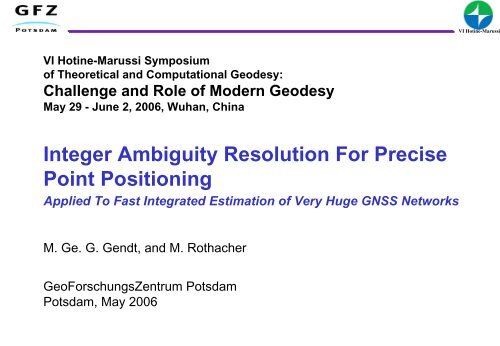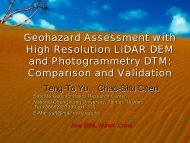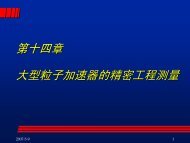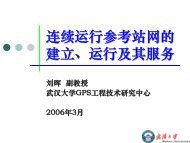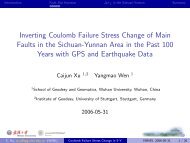Integer Ambiguity Resolution For Precise Point Positioning
Integer Ambiguity Resolution For Precise Point Positioning
Integer Ambiguity Resolution For Precise Point Positioning
Create successful ePaper yourself
Turn your PDF publications into a flip-book with our unique Google optimized e-Paper software.
VI Hotine-MarussiVI Hotine-Marussi Symposiumof Theoretical and Computational Geodesy:Challenge and Role of Modern GeodesyMay 29 - June 2, 2006, Wuhan, China<strong>Integer</strong> <strong>Ambiguity</strong> <strong>Resolution</strong> <strong>For</strong> <strong>Precise</strong><strong>Point</strong> <strong>Positioning</strong>Applied To Fast Integrated Estimation of Very Huge GNSS NetworksM. Ge. G. Gendt, and M. RothacherGeo<strong>For</strong>schungsZentrum PotsdamPotsdam, May 2006
OutlineVI Hotine-Marussi‣ Motivation‣ New Strategy <strong>For</strong> Very Huge Networks‣ Reference Network‣ <strong>Precise</strong> <strong>Point</strong> <strong>Positioning</strong>‣ <strong>Ambiguity</strong> Fixing Approach <strong>For</strong> PPP‣ Solution With Fixed Ambiguities‣ Preliminary Results‣ Summary And Further Work
Motivation (1)VI Hotine-Marussi‣ Procedure <strong>For</strong> Processing Of Daily Data Iteratively Real-valued Solution <strong>For</strong> Data Cleaning <strong>Integer</strong> <strong>Ambiguity</strong> Fixing Fixed SolutionBut Only Fixed Solution Is Required‣ Software Capability Number Of Stations < 100 <strong>For</strong> Most Of The Acs GFZ Extended Up To 400, Best < 250Major Reason: Huge Num. Of Amb. Parameters‣ Integrated Estimation GNSS Networks (More Stations, Multi-systems) Low Earth Orbiting SatellitesMore Amb. Parameters
Motivation (2)VI Hotine-Marussi‣ Any Other Approach <strong>For</strong> Data Cleaning ?If Ambiguities Are Fixed‣ Can We Fix Ambiguities Before Network Solution? PPP <strong>For</strong> Data Cleaning And <strong>Ambiguity</strong> Fixing+ LSQ <strong>For</strong> Fixed Solution
Strategy <strong>For</strong> Very Huge NetworkVI Hotine-Marussi‣ Reference Network ERP, ORBITS, CLOCKS‣ <strong>Precise</strong> <strong>Point</strong> <strong>Positioning</strong> <strong>For</strong> New Stations‣ Clean Data And Fix <strong>Ambiguity</strong> Based OnPPP Results‣ <strong>Ambiguity</strong> Mapping‣ Integrated Solution With Known Ambiguities
VI Hotine-Marussi<strong>Precise</strong> <strong>Point</strong> <strong>Positioning</strong>⎥⎥⎥⎦⎤⎢⎢⎢⎣⎡+⎥⎥⎥⎥⎥⎥⎦⎤⎢⎢⎢⎢⎢⎢⎣⎡⎥⎥⎥⎥⎤⎢⎢⎢⎢⎡=⎥⎥⎥⎦⎤⎢⎢⎢⎣⎡3213213,3.332,2,221,1,11321000000lllxxxxxaaaaaaaaavvverpsaterpsaterpsaterpsat( )( )( )00000003,3,3332,2,2221,1,111321332211=⎥⎥⎥⎦⎤⎢⎢⎢⎣⎡+++++++⎥⎥⎥⎦⎤⎢⎢⎢⎣⎡⎥⎥⎥⎦⎤⎢⎢⎢⎣⎡erperpsatsatTerperpsatsatTerperpsatsatTxaxalaxaxalaxaxalaxxxNNN‣ PPP == Network + Fixed ORB CLK ERP( ) 0,, =+++ erperpisatsatiiTiiiiixaxalaxN
<strong>Precise</strong> <strong>Point</strong> <strong>Positioning</strong>VI Hotine-Marussi‣ AccuraciesDepends On “Products Used” Model Consistence‣ Advantages : Simple, Fast and Run Parallel‣ Disadvantages : No Full Covariance, No FixedSolutionIF Ref. Net Is Dense Enough, Additional StationsWill Not Change Network Solution Very Much.Data Cleaning Using PPP Residuals<strong>Ambiguity</strong> Fixing Based On PPP Results
Uncalibrated Phase Delay in Sat&Rec.VI Hotine-Marussi‣ Basic Observation Model (Freq. i)Li=ρ −κ/fi2+ λ biiPi=ρ + κ /fi2b + +i= δpδprec, i sat,iNi‣ Uncalibrated Phase Delay Originating In TheSatellite And Receiver‣ Can Only <strong>For</strong>m SD Between Satellites
<strong>Ambiguity</strong> Fixing <strong>For</strong> LC Solution‣ LC <strong>Ambiguity</strong> (Estimated)Lc= α L −αL =1 1 2 2ρ+bcVI Hotine-Marussibcw=βLfwbwff+Lβ‣ Wide-Lane (Range&Phase Combination)L=f−−‣ Narrow-Lane111222−nfb1nPf11++ff22P2= λ b + εwwwbn=( b − β b ) λc w w n
WL--Estimation Of Uncalibrated DelayVI Hotine-Marussi1. Difference Of Wide-lane Between Satellites i, jΔbw( i,j,l)=bw( i,l)over _ epoch−bw(j,l)over _ epoch=( Δδp+ ΔNwsat , i , j i,j,l)
WL--Estimation Of Uncalibrated DelayVI Hotine-Marussi2. Constant ? Yes Data Piece > 30 Minutes Stable In Time And Space (Gaps, Days)
WL--Estimation Of Uncalibrated DelayVI Hotine-Marussi3. Estimated Fractional Part Fractional Part: From -1.40 0.70 To -0.40 -0.30 ? RMS=0.1, STD=0.014 CyclesΔδpw= Δb( i,j,l)− Δsat : i , j wNi,j,lover _ all _ stations150Fractional Part of WL Bias[Cycle]0,750,2510050Number of WL Pairs-0,253231302928272625242322212019181716151413121110987654321Satellite PRN0
WL– Uncalibrated Delay <strong>For</strong> Fixing‣ Fixing Based on Estimated Uncalibrated DelayVI Hotine-MarussiΔbw( i,j,l)+ Δδpsat,i,j−nint( )Δb( i,j,l)+ Δδpwsat,i,j
WL– Uncalibrated Delay <strong>For</strong> FixingVI Hotine-Marussi‣ Results (Receivers Used: AOAD/ASH/TRM=5/3/1)Fixing Rate <strong>For</strong> All 93%, <strong>For</strong> Independent 99%Lower Fixing Rate 75% <strong>For</strong> CrossCorrel. ReceiversTRIM29659.00+ASHREC (100%) AOA/M_T+TRIMREC (76%)
Uncalibrated Delay --- Narrow-Lane(1)‣ Difference Of Narrow-Lane Between SatellitesnΔb( i,j,l)= b ( i)− b ( j)= Δδp+ Δnn( )nnlsat , i , ji , j , lVI Hotine-MarussiΔδpnsat , i , j=Δbn( i,j,l)− Δni , j , l‣ Constant ? NOTime/Position Dependent Bias, Up To 5cmGood Agreement Within A Time Interval
Uncalibrated Delay --- Narrow-Lane(2)‣ CorrectionΔδpn= Δbi j lsat , i , j n, , )( − Δni , j , lUsing Average Of All SD NL ( 79%)Using Only SD NL With > 10 Min Common Data (> 94%)Fixing Rate Of Independent Should Be HigherVI Hotine-Marussi
<strong>Integer</strong> <strong>Ambiguity</strong> Substitution‣ DD-Ambiguities To UDVI Hotine-Marussi⎡b1⎤⎢b⎥⎢2⎥⎢⎣d ⎥⎦⎡ I=⎢⎢0⎢D10ID2‣ Integrated Fixed Solution00D3⎤⎡b⎥⎢⎥⎢b⎥⎢⎣b123⎤⎥⎥⎥⎦→b3=D b b 1 reference ambiguities, selected freely d fixed DD-ambiguities, known values22+( D d + D b ) b 2 represent unfixable DD-ambiguities, to form afull rank transformation Only very small number of b 3 link with b 2 , most ofthem are constants311
Procedure Of The StrategyVI Hotine-Marussi‣ Reference Network‣ Estimate Phase Delay <strong>For</strong> SD WL, And Fix SD WL‣ Generate SD NL Ambiguities Using fixed SD WL‣ PPP <strong>For</strong> Additional Stations‣ Fixing WL Using WL PD, Calculate SD NL‣ Fixing NL Using NL PD From Nearby Station(s)‣ <strong>Ambiguity</strong> Transformation‣ Integrated Estimation (With Known Ambiguities)
Validation (1)VI Hotine-Marussi‣ EPOS Software At GFZ‣ Reference Network 95 IGS Stations‣ 96 Additional IGS Stations‣ New Strategy (95 + 96 PPP) VS‣ Current Strategy (191 Stations)
Validation (2)VI Hotine-Marussi<strong>For</strong> The New Stations‣ 98% WL Ambiguities Fixable (Independent)‣ 91% Of ~25000 NL, 96% of Independent‣ Fixing Rate Of Independent ~94%
Validation (3)VI Hotine-MarussiFixed Solution‣ Fixable Ambiguities Are IntroducedInto NEQ As Constraints‣ Coordinate RMS 0.2,0.2,0.5mmCompared with Current Strategy
Summary And Further WorkVI Hotine-Marussi‣ With GPS data we demonstrated the uncalibratedphase delay is very stable. can be estimated preciselyand applied to ambiguity-fixing for PPP (94%).‣ By using PPP+Amb.Fix, a new strategy is developedfor very huge GNSS networks in order to savememory and computation time‣ Applicable to users with own PPP software forregional Network, where NL might be also a constant‣ It will improve PPP results, especially for Short TimeData and Moving Object, as well as ZTD/Slant Delay.‣ With increasing range accuracy and better IGSproducts, it might be able to challenge the currentVRS system.


